| 1 |
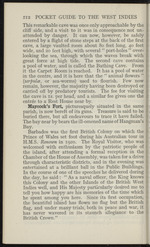 |
“...near by.
Maycock’s Fort, picturesquely situated in the same |
parish, is now bereft of its guns. Treasure is said to be I j
buried there, but all endeavours to trace it have failed. |j
The bay near by bears the ill-omened name of Hangman’s |,
Bay. I
Barbados was the first British Colony on which the l|
Prince of Wales set foot during his Australian tour in j(
H.M.S. Renown in 1920. The Royal Visitor, who was I;
welcomed with enthusiasm by the patriotic people of 1
the island, after attending a formal reception in the |
Chamber of the House of Assembly, was taken for a drive I
through characteristic districts, and in the evening was |
entertained at a brilliant ball in the Public Buildings. I
In the course of one of the speeches he delivered during l;
the day, he said: “ As a naval officer, the King knows j
this Colony and the other Islands of the British West
Indies well, and His Majesty particularly desired me to p
tell you how happy are his memories of the time which |
he spent among you...”
|
|
| 2 |
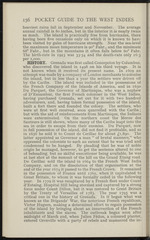 |
“...when it received its present name. In 1609 an
attempt was made by a company of London merchants to colonise
the island, but in less than a year the settlers were driven off
by the Caribs. The island was included in the possessions of
the French Company of the Islands of America, and in 1650
Du Parquet, the Governor of Martinique, who was a nephew
of D’Esnambuc, the first French coloniser in the West Indies,
having purchased Grenada, set out for it with two hundred
adventurers, and, having taken formal possession of the island,
built a fort there and founded the colony. The settlers, who
were at first well received, soon quarrelled with the Caribs;
but with the aid .of reinforcements from Martinique, the Indians
were exterminated. On the northern coast the Mome des
Sauteurs is still shown, where many of the Caribs leapt into the
sea in order to escape from their enemies. Du Parquet, now
in full possession of the island, did not find it profitable, and so
in 1656 he sold it to Count de Cerillac...”
|
|
| 3 |
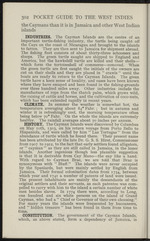 |
“...been attributed by the late Dr. G. S. S. Hirst, Commissioner
from 1907 to 1912, to the fact that early settlers found alligators,
or “ cayman ” as they are still called in Jamaica, in the lesser
islands. Another ingenious though less plausible suggestion
is that it is derivable from Cay Mano—the cay like a hand.
With regard to Cayman Brae, we are told that Brae is
synonymous with “ Bluff.” The islands were never occupied
by the Spaniards, but were mainly settled by English from
Jamaica. Their formal colonisation dates from 1734, between
which year and 1741 a number of patents of land were issued.
The present inhabitants are mainly the descendants of the
original settlers and their servants, as each patentee was com-
pelled to carry with him to the island a certain number of white
men besides slaves. In 1774 there were, according to Long,
one hundred and six white persons on the island of Grand
Cayman, who had a " Chief or Governor of their own choosing.”
For many years the islands were ...”
|
|
| 4 |
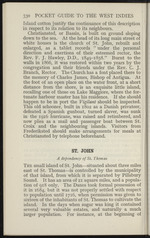 |
“...retimbered, and
now plies as a mail and passenger boat between St.
Croix and the neighbouring islands. Visitors from
Frederiksted should make arrangements for meals at
Christiansted by telephone beforehand.
ST. JOHN
A dependency of St. Thomas
The small island of St. John—situated about three miles
east of St. Thomas—is controlled by the municipality
of that island, from which it is separated by Pillsbury
Sound. It has an area of 21 square miles, and a popula-
tion of 918 only. The Danes took formal possession of
it in 1684, but it was not properly settled with respect
to population until 1716, when permission was given to
sixteen of the inhabitants of St. Thomas to cultivate the
island. In the days when sugar was king it contained
several very valuable estates, and naturally a much
larger population. For instance, at the beginning of...”
|
|
| 5 |
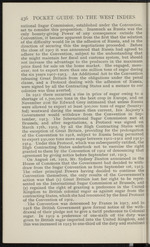 |
“...continue the
Convention themselves, the only results of the Government's
action was that (1) Great Britain lost her right to be repre-
sented on the International Sugar Commission at Brussels, and
(2) regained the right of granting a preference in the United
Kingdom to British colonial sugar as against sugar from the
contracting States, which she had renounced by the final Protocol
of the Convention of 1902.
lhe Convention was denounced by France in 1917, and in
1918 the British Government gave formal notice of the with-
drawal of their pledge not to give a tariff preference to Colonial
sugar. In 1919 a preference of one-sixth off the duty was:
given to British sugar imported into the United Kingdom, and
this was increased in 1925 to one-third off the duty and stabilised j...”
|
|
